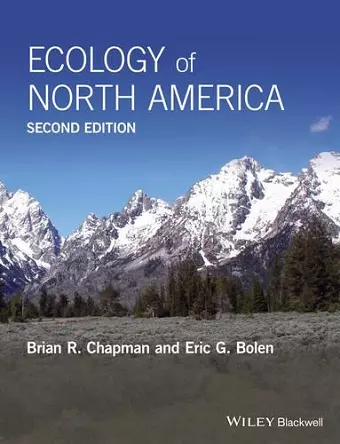Ecology of North America
Brian R Chapman author Eric G Bolen author
Format:Hardback
Publisher:John Wiley & Sons Inc
Published:4th Sep '15
Currently unavailable, and unfortunately no date known when it will be back

North America contains an incredibly diverse array of natural environments, each supporting unique systems of plant and animal life. These systems, the largest of which are biomes, form intricate webs of life that have taken millennia to evolve. This richly illustrated book introduces readers to this extraordinary array of natural communities and their subtle biological and geological interactions.
Completely revised and updated throughout, the second edition of this successful text takes a qualitative, intuitive approach to the subject, beginning with an overview of essential ecological terms and concepts, such as competitive exclusion, taxa, niches, and succession. It then goes on to describe the major biomes and communities that characterize the rich biota of the continent, starting with the Tundra and continuing with Boreal Forest, Deciduous Forest, Grasslands, Deserts, Montane Forests, and Temperature Rain Forest, among others. Coastal environments, including the Laguna Madre, seagrasses, Chesapeake Bay, and barrier islands appear in a new chapter. Additionally, the book covers many unique features such as pitcher plant bogs, muskeg, the polar ice cap, the cloud forests of Mexico, and the LaBrea tar pits. “Infoboxes” have been added; these include biographies of historical figures who provided significant contributions to the development of ecology, unique circumstances such as frogs and insects that survive freezing, and conservation issues such as those concerning puffins and island foxes. Throughout the text, ecological concepts are worked into the text; these include biogeography, competitive exclusion, succession, soil formation, and the mechanics of natural selection.
Ecology of North America 2e is an ideal first text for students interested in natural resources, environmental science, and biology, and it is a useful and attractive addition to the library of anyone interested in understanding and protecting the natural environment.
"The disciplines of ecology and biogeography are so closely intertwined that many scholars of these
respective fields are, by necessity and shared interest, well versed in both (Jenkins and Ricklefs
2011). This overlap is evident in the layout of Ecology of North America. With a scalable subject such
as ecosystems, the authors could have approached the discussion of their material from various angles. Their decision to employ a biomestructured theme to describe the assemblage of North American ecosystems is both logical and practical. This approach is certain to be appealing to biogeographers who use the textbook. In fact, this book could be used as a supplementary textbook
in a biogeography class. Ecology of North America will serve as a good introductory text for students interested in the ecology of the continent. The book begins with an overview chapter of basic ecological principles and terms, including sound explanations of succession, biodiversity, and biogeography. Subsequent chapters are individually devoted to various North American ecosystems/biomes. These chapters define the unique attributes of each biome and fluidly address the important abiotic and biotic components of each, along with representative plant and animal assemblages, interactions, and
adaptations, as well as characteristic biome-level disturbances and ecological challenges. Both authors
are wildlife ecology experts, yet their knowledge and understanding of plant ecology and their success in balancing the text between floral and faunal ecological discussions are both refreshing and impressive.....The inclusion of “infoboxes” is a meaningful addition; this type of aside succeeds in adding interest and depth to textbooks. Comprehensive bibliographies are included after each chapter,
and the division of each one by chapter subheadings is helpful......The new edition of Ecology of North
America is a welcome addition to contemporary ecology textbook offerings. The authors have updated
a good introductory text that is highly approachable and readable. It offers a worthy addition
to textbook options in the discipline, and I recommend it as an essential resource for students
and teachers of North American ecosystems" (Frontiers of Biogeography- December 2016)
ISBN: 9781118971543
Dimensions: 254mm x 196mm x 22mm
Weight: 925g
352 pages
2nd edition